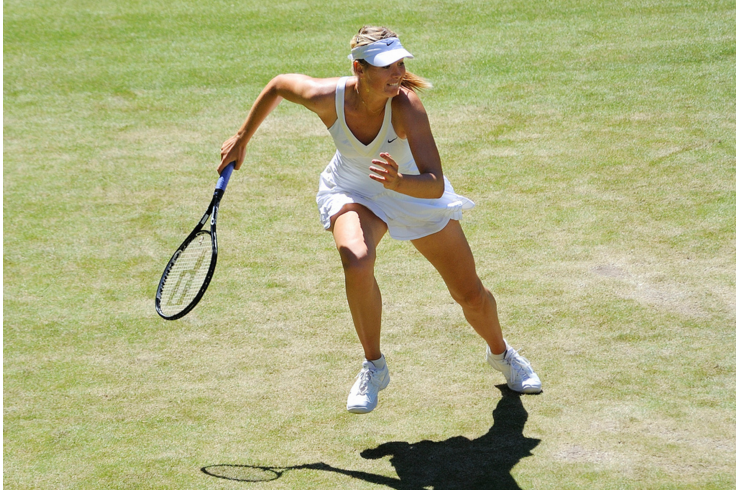Beyond the Game: Maria Sharapova’s admission to using meldonium raises concerns about drugs and gender-bias in sports
Maria Sharapova was the highest paid female athlete in 2015 with a total earnings of $29.7 million. After she admitted to using a recently banned substance known as meldonium, several major sponsors have suspended their deals with the tennis star. Her situation has spawned a debate around drug use and gender bias in the sports world.
March 15, 2016
Maria Sharapova, seventh-ranked women’s tennis player in the world, admitted to testing positive at the Australian Open for the recently banned drug meldonium in a press conference on March 8.
According to Sharapova, she had been taking mildronate (also known as meldonium) for the past 10 years to treat medical conditions, but she was unaware that the World Anti-Doping Agency (WADA) had added the drug to a list of banned substances at the start of 2016. According to TIME, many eastern European countries commonly use meldonium as a means of improving oxygen intake and reducing the risk of severe heart problems. In her statement, Sharapova also cited her family history with diabetes as a reason for taking the drug in 2006.
The 5-time Grand Slam Champion’s admission garnered a certain respect for the tennis star’s proactiveness to publicly announce such a wrongdoing, but, at the end of the day, the social reverberations emanating from her admission spread far and wide and the situation ultimately questions the true pervasiveness of performance-enhancing drugs (PEDs) in professional sports.
Ronda Rousey, Serena Williams, Alex Morgan, Maria Sharapova*: prime examples of the heroines of contemporary sports culture. Along with the burdening weight of fulfilling idealistic expectations as professional athletes, these individuals and many other strive to shine in an arguably male-dominated industry as female professional athletes.
Female athletes are pioneers and even rebels in the sports industry, which typically portrays males as the most dominant athletes. It seems almost as if the spotlight of fame, and criticism, shines more intensely on the female professional athlete as opposed to her male counterpart, simply because there are less of the former and more of the latter. Yet, female athletes aren’t “female athletes;” they’re athletes.
Consider the defeats of UFC superstars Ronda Rousey and Conor McGregor. Both individuals handled insurmountable pressure to uphold high expectations going into their respective fights. Yet, many people lashed out at Rousey for her presumptuous comments and arrogant disposition before her fight against Holly Holm, while McGregor displayed the same actions and attitudes before his fight against Nate Diaz but didn’t receive the same degree of adverse responses. Critics may argue that comparing the losses of Rousey and McGregor is comparing apples and oranges, but what if the major factor differentiating the apple from the orange was gender?
Similarly, Sharapova’s case has warranted a knee-jerk reaction from her sponsors and even her fans. Nike suspended its $70 million deal until the star’s investigation is complete. Porsche also canceled its current endorsements with Sharapova. Companies such as Evian found her confessions surprising and are now watching this situation more closely.
Plainly, Sharapova violated the rules. But let’s keep in mind that she allegedly took meldonium without illicit intent and that she, not tabloids or sports websites, reported her own mistake.
And let’s also not forget that she isn’t the first to be involved with banned substances, and she definitely won’t be the last. Several well-known male athletes, such as Lance Armstrong, Alex Rodriguez and Pete Rose, have been busted for using PEDs, and many of them are still allowed to compete. It’s safe to assume that multiple other cases around intentional drug abuse fly under the radar every year throughout the sports industry.
While the Russian tennis star’s fans may fear the gravity of her inevitable suspension and the impact of this investigation on her future, this discussion on drug policies in sports should make fans of all sports wonder if distinguished athletes taking not illegal (slightly different from “legal”) drugs today are actually enhancing their performance.



















![“[Building nerf blasters] became this outlet of creativity for me that hasn't been matched by anything else. The process [of] making a build complete to your desire is such a painstakingly difficult process, but I've had to learn from [the skills needed from] soldering to proper painting. There's so many different options for everything, if you think about it, it exists. The best part is [that] if it doesn't exist, you can build it yourself," Ishaan Parate said.](https://harkeraquila.com/wp-content/uploads/2022/08/DSC_8149-900x604.jpg)




![“When I came into high school, I was ready to be a follower. But DECA was a game changer for me. It helped me overcome my fear of public speaking, and it's played such a major role in who I've become today. To be able to successfully lead a chapter of 150 students, an officer team and be one of the upperclassmen I once really admired is something I'm [really] proud of,” Anvitha Tummala ('21) said.](https://harkeraquila.com/wp-content/uploads/2021/07/Screen-Shot-2021-07-25-at-9.50.05-AM-900x594.png)







![“I think getting up in the morning and having a sense of purpose [is exciting]. I think without a certain amount of drive, life is kind of obsolete and mundane, and I think having that every single day is what makes each day unique and kind of makes life exciting,” Neymika Jain (12) said.](https://harkeraquila.com/wp-content/uploads/2017/06/Screen-Shot-2017-06-03-at-4.54.16-PM.png)








![“My slogan is ‘slow feet, don’t eat, and I’m hungry.’ You need to run fast to get where you are–you aren't going to get those championships if you aren't fast,” Angel Cervantes (12) said. “I want to do well in school on my tests and in track and win championships for my team. I live by that, [and] I can do that anywhere: in the classroom or on the field.”](https://harkeraquila.com/wp-content/uploads/2018/06/DSC5146-900x601.jpg)
![“[Volleyball has] taught me how to fall correctly, and another thing it taught is that you don’t have to be the best at something to be good at it. If you just hit the ball in a smart way, then it still scores points and you’re good at it. You could be a background player and still make a much bigger impact on the team than you would think,” Anya Gert (’20) said.](https://harkeraquila.com/wp-content/uploads/2020/06/AnnaGert_JinTuan_HoHPhotoEdited-600x900.jpeg)

![“I'm not nearly there yet, but [my confidence has] definitely been getting better since I was pretty shy and timid coming into Harker my freshman year. I know that there's a lot of people that are really confident in what they do, and I really admire them. Everyone's so driven and that has really pushed me to kind of try to find my own place in high school and be more confident,” Alyssa Huang (’20) said.](https://harkeraquila.com/wp-content/uploads/2020/06/AlyssaHuang_EmilyChen_HoHPhoto-900x749.jpeg)










